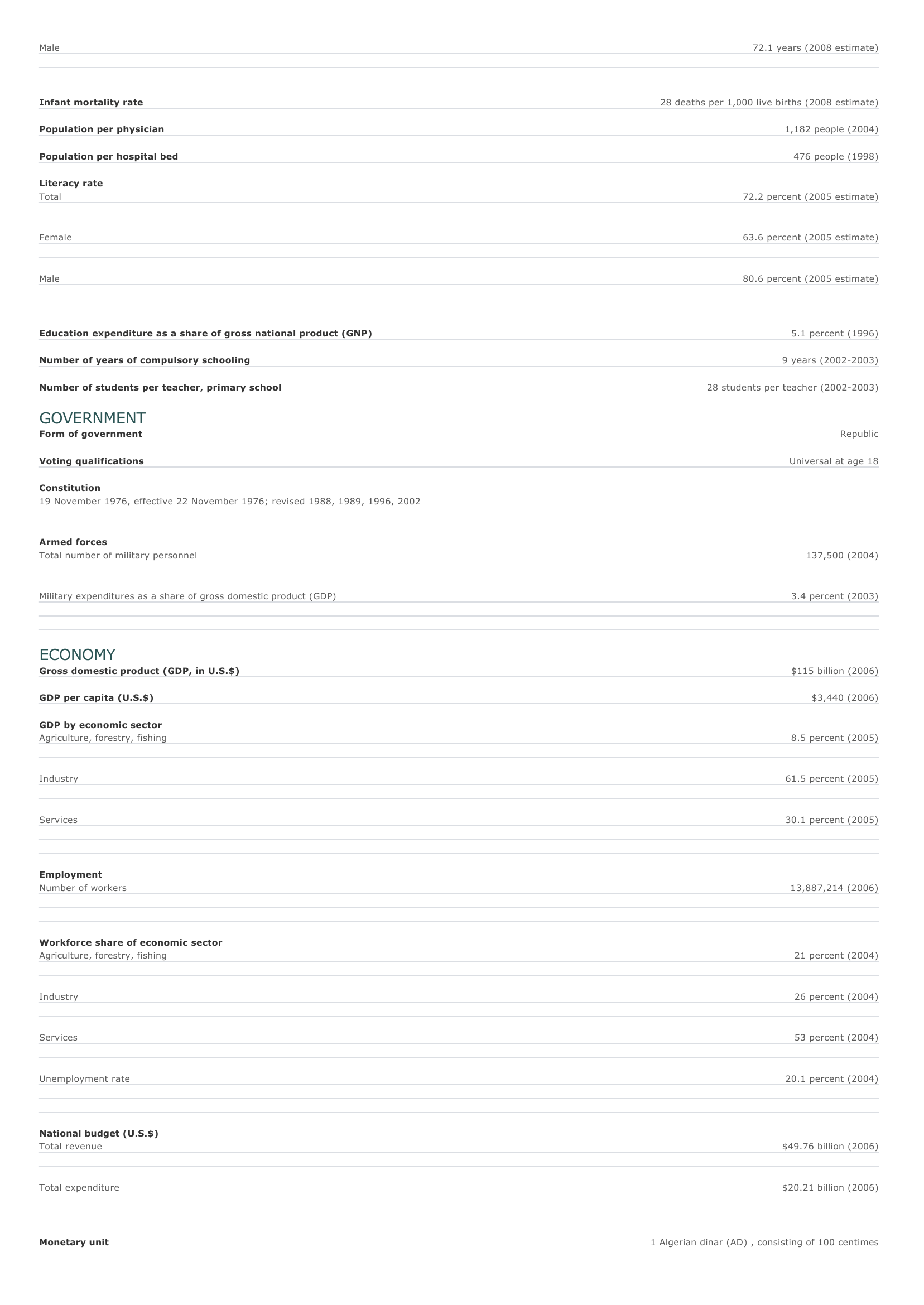Algeria Facts and Figures. BASIC FACTS Official name Democratic and Popular Republic of Algeria Capital Area Algiers 2,381,741 sq km 919,595 sq mi PEOPLE Population Population growth Population growth rate 33,739,635 (2008 estimate) 1.21 percent (2008 estimate) Projected population in 2025 40,254,833 (2025 estimate) Projected population in 2050 43,983,870 (2050 estimate) Population density 14 persons per sq km (2008 estimate) 37 persons per sq mi (2008 estimate) Urban/rural distribution Share urban 60 percent (2005 estimate) Share rural 40 percent (2005 estimate) Largest cities, with population Algiers 3,060,000 (2003 estimate) Oran 655,852 (1998) Constantine 462,187 (1998) Ethnic groups Arab 83 percent Berber 16 percent European Less than 1 percent Languages Arabic (official), Tamazight, Berber dialects, French Religious affiliations Muslim (Islam is the official religion) 96 percent Nonreligious 3 percent Christian, Jewish, and other 1 percent HEALTH AND EDUCATION Life expectancy Total 73.8 years (2008 estimate) Female 75.5 years (2008 estimate) Male Infant mortality rate Population per physician Population per hospital bed 72.1 years (2008 estimate) 28 deaths per 1,000 live births (2008 estimate) 1,182 people (2004) 476 people (1998) Literacy rate Total 72.2 percent (2005 estimate) Female 63.6 percent (2005 estimate) Male 80.6 percent (2005 estimate) Education expenditure as a share of gross national product (GNP) Number of years of compulsory schooling Number of students per teacher, primary school 5.1 percent (1996) 9 years (2002-2003) 28 students per teacher (2002-2003) GOVERNMENT Form of government Republic Voting qualifications Universal at age 18 Constitution 19 November 1976, effective 22 November 1976; revised 1988, 1989, 1996, 2002 Armed forces Total number of military personnel Military expenditures as a share of gross domestic product (GDP) 137,500 (2004) 3.4 percent (2003) ECONOMY Gross domestic product (GDP, in U.S.$) GDP per capita (U.S.$) $115 billion (2006) $3,440 (2006) GDP by economic sector Agriculture, forestry, fishing 8.5 percent (2005) I ndustry 61.5 percent (2005) Services 30.1 percent (2005) Employment Number of workers 13,887,214 (2006) Workforce share of economic sector Agriculture, forestry, fishing 21 percent (2004) I ndustry 26 percent (2004) Services 53 percent (2004) Unemployment rate 20.1 percent (2004) National budget (U.S.$) Total revenue $49.76 billion (2006) Total expenditure $20.21 billion (2006) Monetary unit 1 Algerian dinar (AD) , consisting of 100 centimes Major trade partners for exports Italy, United States, France, Spain, Netherlands Major trade partners for imports France, United States, Italy, Germany, Spain ENERGY, COMMUNICATIONS, AND TRANSPORTATION Electricity production Electricity from thermal sources Electricity from hydroelectric sources 99.83 percent (2003 estimate) 0.17 percent (2003 estimate) Electricity from nuclear sources 0 percent (2003 estimate) Electricity from geothermal, solar, and wind sources 0 percent (2003 estimate) Number of radios per 1,000 people 242 (1997) Number of telephones per 1,000 people 78 (2005) Number of televisions per 1,000 people 107 (2000 estimate) Number of Internet hosts per 10,000 people 0.27 (2003) Daily newspaper circulation per 1,000 people 27 (1998) Number of motor vehicles per 1,000 people 53 (1997) Paved road as a share of total roads 70 percent (2004) SOURCES Basic Facts and People sections Area data are from the statistical bureaus of individual countries. Population, population growth rate, and population projections are from the United States Census Bureau, International Programs Center, International Data Base (IDB) (www.census.gov). Urban and rural population data are from the Food and Agriculture Organization (FAO) of the United Nations (UN), FAOSTAT database (www.fao.org). Largest cities population data and political divisions data are from the statistical bureaus of individual countries. Ethnic divisions and religion data are largely from the latest Central Intelligence Agency (CIA) World Factbook and from various country censuses and reports. Language data are largely from the Ethnologue, Languages of the World, Summer Institute of Linguistics International (www.sil.org). Health and Education section Life expectancy and infant mortality data are from the United States Census Bureau, International Programs Center, International database (IDB) (www.census.gov). Population per physician and population per hospital bed data are from the World Health Organization (WHO) (www.who.int). Education data are from the United Nations Educational, Scientific and Cultural Organization (UNESCO) database (www.unesco.org). Government section Government, independence, legislature, constitution, highest court, and voting qualifications data are largely from various government Web sites, the latest Europa World Yearbook, and the latest Central Intelligence Agency (CIA) World Factbook. The armed forces data is from Military Balance. Economy section Gross domestic product (GDP), GDP per capita, GDP by economic sectors, employment, and national budget data are from the World Bank database (www.worldbank.org). Monetary unit, agriculture, mining, manufacturing, exports, imports, and major trade partner information is from the statistical bureaus of individual countries, latest Europa World Yearbook, and various United Nations and International Monetary Fund (IMF) publications. Energy, Communication, and Transportation section Electricity information is from the Energy Information Administration (EIA) database (www.eia.doe.gov). Radio, telephone, television, and newspaper information is from the United Nations Educational, Scientific and Cultural Organization (UNESCO) database (www.unesco.org). Internet hosts, motor vehicles, and road data are from the World Bank database (www.worldbank.org). Note Figures may not total 100 percent due to rounding. Microsoft ® Encarta ® 2009. © 1993-2008 Microsoft Corporation. All rights reserved.






